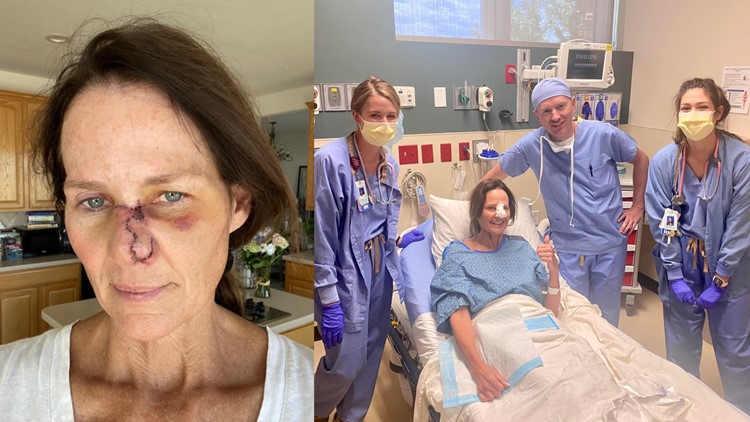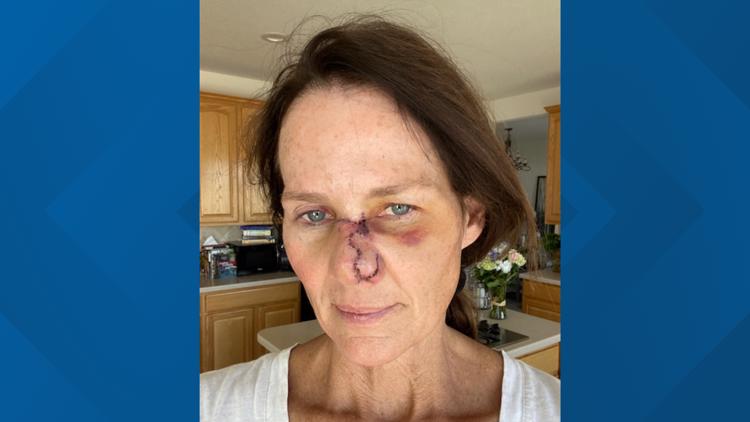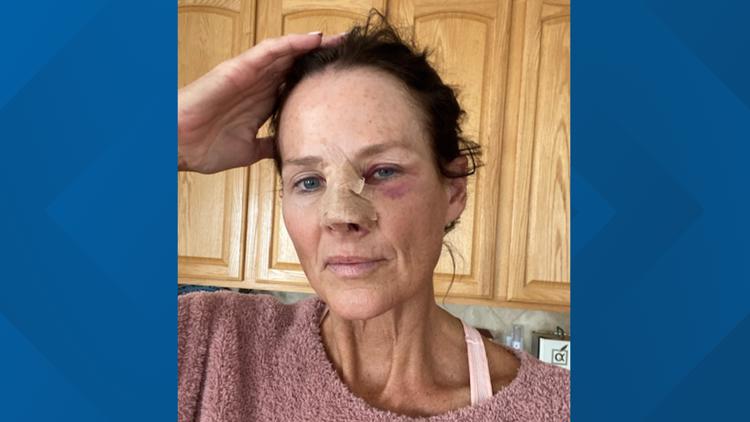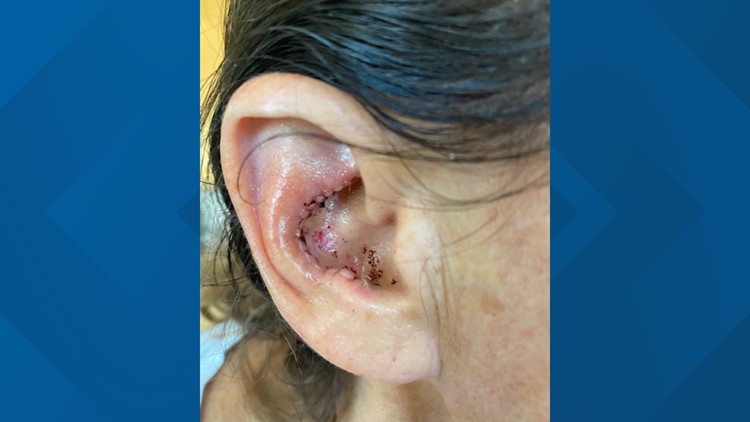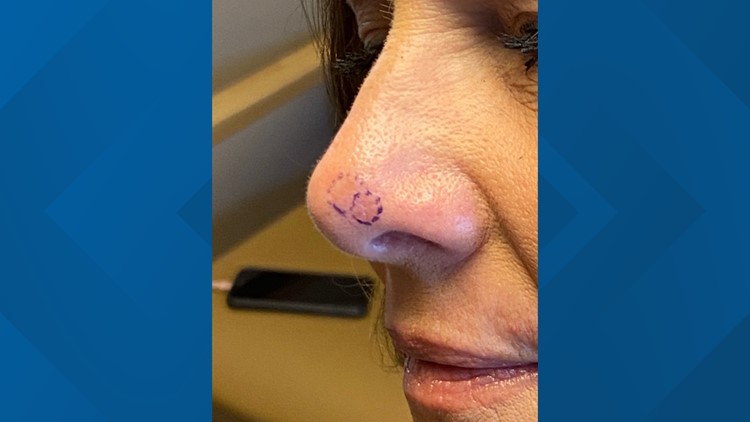DENVER — Skin cancer. Two words spoken by her dermatologist at what seemed to be a routine visit quickly changed the course of Kathy Sabine's journey.
"I never thought it would happen to me," Sabine, a 9NEWS meteorologist, said. "I wasn’t going in looking for something. I didn’t really have something I was super concerned about."
Sabine said her doctor leaned in closer to take a look at the skin on her face, thought she saw basal cell carcinoma and ordered a punch biopsy for the next week.
Sabine was shell-shocked.
"I was like, 'What?!'" she said.
Dermatologists hold insight into your skin's health that a primary doctor could miss.
"It’s a significant skill these dermatologists have, looking at something that to you or I may look like a little blemish or a pimple and recognizing that might be skin cancer," said plastic surgeon Dr. David Archibald at Castle Rock Adventist Hospital.
When Sabine's dermatologist delivered the skin cancer news, he was grateful to pass along some good news. It wasn't melanoma, one of the fastest-growing cancers that can metastasize quickly.
"If you don’t catch it early, the rate of survival is less than 20%," Archibald said.
Instead, he told Sabine, it was a slow-growing basal cell carcinoma, with a low probability of killing someone, but something that needed immediate attention.
He explained it wouldn't be one surgery, but instead two surgeries. Sabine was trepidatious.
"I asked, 'If it’s slow growing and won’t kill you, why do you want to cut up my face?'" Sabine said. "Because I work in TV, hello. I'm a girl, and this is my face."
Her doctor agreed that it's a surgery that's hard to face.
"It's hard. It's your face. It's very different than having surgery on other parts of your body that you can hide," Archibald said. "There's no hiding these incisions, these scars, and for a loved one, the initial shock is that yes, it's significant."
What's interesting, said Archibald, is, "People evolve through this process, and these skin cancers are kind of like trees – you see the tree on the surface, but then there’s the whole root system underneath."
Sabine's surgery story
Doctors expected Sabine to be in surgery for one cut that would take about an hour.
"For me, it was four cuts and four hours, and in the process, they did a second biopsy on the top of my nose, and she found a third one between my eyes – so they did a second Mohs surgery," Sabine said.
Her doctor explained how surgeons borrowed cartilage from Sabine's ear to replace the missing cartilage on her nose. The surgeries were an effort to make sure her nose looks good, but to also make sure it still functions well.
"So we borrowed some cartilage from her ear and replaced the missing skin we removed when we removed the cancer," Archibald said. "Then we made incisions on the side of her nose and repositioned the skin to cover the wound, so it's kind of borrowing from Peter to pay Paul."
Sabine described the reconstruction as "amazing."
"They pulled skin down from my forehead and used skin from my cheek," Sabine said. "He couldn't do any grafting because of where it was, so what he was able to do is pretty remarkable."
After the surgery, doctors wouldn't let her see the scars. It was Sabine's husband who saw her first.
"I think the hardest part for me was when I went to the surgeon's office and they took the Band-Aids off," Sabine said. "My husband knew what was coming, but I didn't, and we had to have our son with us, our 14-year-old son, and when he saw me, he started crying."
The reveal was pretty shocking to Sabine.
"I had a hole by my eye and that made me cry because that was really scary looking because they didn't suture it," Sabine said. "I'm still struggling in that area with healing."
Building community after cancer
After the Mohs surgery, Sabine said she felt alone and sometimes scared, but she found that by sharing her story she was building a sense of community.
Sabine was inside her house for four weeks to limit exposure to the sun, and she didn't want to go out in public because of the sutures on her face.
"The little I put out there about my story, it came back to me fourfold with other people sharing their stories," she said. "It affects so many people, and they aren't talking about it because most have cancer removed if it's on their arm or back, but if you're a woman especially, I've learned that when you have a big surgery on your face, there's potential for disfigurement."
Many people are isolated in their homes, and they hide.
"I've learned people don't talk about it," she said. "Some have quit their jobs and become isolated and depressed."
Kathy Sabine shares her skin cancer journey
The "Kathy Sabine effect"
Sabine's doctor performs anywhere from 20 to 30 skin cancer removal surgeries in a week, and said the new attention being paid to prevent skin cancer is the "Kathy Sabine effect."
"I mean, her being so vulnerable and vocal and using her platform for good – talk to any dermatologist in this area and their phone is ringing off the hook," Archibald said.
Sabine's vulnerability in sharing her story inspired others facing skin cancer that they can get through this, too.
"All of sudden, I had so many people sharing with me – their pictures, their stories," Sabine said. "If I can say, 'Look, I don't look perfect – I may never look perfect and be back to where I was – I'm back to work. I'm back to my life – you can do it too.'"
Archibald's patients often ask if they will have a scar on their faces after the surgery.
"The answer is yes, but we hope that it's something very manageable and not noticed by other people," Archibald said. "And maybe there's some wisdom in having scars."
Archibald said patients can view their scars as a reminder that they went through something that was really difficult and challenging, and came out on the other side.
Doctors removed all of her cancer, and Sabine will be fine.
"But I'm still recovering," she said.
Sabine said many people have questioned her motivation in putting out her post-surgery pictures to the public.
"I've been here for 30 years," she said. "People have followed me online and on my social media through having babies, getting divorced and getting remarried. I've shared my life with our 9NEWS viewers. This was another chapter I wanted to share."
Skin cancer is called an epidemic in Colorado, with rates of skin cancer rising at every thousand feet in elevation.
"It takes 10 minutes in a doctor's or dermatologist's office for them to see something we can't see that can literally save your life," she said. "I just feel like, if I can save one life or just be an inspiration to someone and remind them that they will get their life back."
Moving forward
At first, Sabine questioned her habits when she's been under the sun.
"I have a wonderful relationship with the sun. I always thought I had a healthy respect for the sun," Sabine said. "I thought I did everything right – wearing my sunscreen and my hat and getting yearly skin checks, but now I have an even greater respect and a fear of the sun."
Sabine said doctors were quick to correct her by telling her that it wasn't something she had done in the last 10 years, but in fact, much longer ago, when she was 10 years old or 20-something.
"We need to take care of our kids. We need to get that sunscreen on them," Sabine said. "I still go out in the sun. I celebrate the outdoors. But I am even more careful than I was before."
She said she has a healthy fear of the sun now.
"Doctors said that if you have basal cell carcinoma, and then I had a second squamous cell, I'm very likely to have more."
Sabine's scar is still healing, and she will have to go back to the doctor and get her skin checked every three months.
"For whatever reason, I'm the face of skin cancer in Colorado right now," Sabine said. "Good or bad, I need to use this moment and this platform to tell people to get the facts, get checked, do what you need to do. It could save your life."
Skin cancer resources
There are 5 million cases of non-melanoma skin cancer in the U.S. every year, affecting about 3 million people. One in five people get skin cancer in their lifetimes.
Here are some skin cancer resources for more information:
SUGGESTED VIDEOS: Latest from 9NEWS



